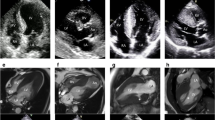Abstract
Asymmetric septal hypertrophic cardiomyopathy (ASH) is the common phenotype of hypertrophic cardiomyopathy (HCM). We sought to classify ASH using magnetic resonance imaging (MRI) and to determine whether the MRI classification of ASH is related to the presence of risk factors for HCM. Ninety-three patients with ASH underwent cine and delayed-enhancement MRI. The ASH was classified morphologically using cine MRI at end-diastole. We evaluated the association between the MRI findings and the presence of risk factors in the ASH. The ASH was classified into three subtypes by MRI: contiguous subtype showing various clinical and MRI features (57%), sigmoid subtype (29%) with fewer risk factors, and reverse-curve subtype (14%) in younger patients with the larger myocardial mass and delayed-enhancement, which were significantly related to the risk factors. MRI was used to classify ASH into three subtypes, which might be related to the presence of risk factors.



Similar content being viewed by others
References
Maron BJ, Bonow RO, Cannon RO III, Leon MB, Estein SE (1987) Hypertrophic cardiomyopathy: interrelations of clinical manifestations, pathophysiology, and therapy. N Engl J Med 316:780–789
Wigle ED, Rakowski H, Kimball BP, Williams WG (1995) Hypertrophic cardiomyopathy. Clinical spectrum and treatment. Circulation 92:1680–1692
Marian AJ (2010) Hypertrophic cardiomyopathy: from genetics to treatment. Eur J Clin Invest 40:360–369
Maron BJ, Gottdiener JS, Epstein SE (1981) Patterns and significance of distribution of left ventricular hypertrophy in hypertrophic cardiomyopathy. A wide angle, two dimensional echocardiographical study of 125 patients. Am J Cardiol 48:418–428
Klues HG, Schiffers A, Maron BJ (1995) Phenotypic spectrum and patterns of left ventricular hypertrophy in hypertrophic cardiomyopathy: morphologic observations and significance as assessed by two-dimensional echocardiography in 600 patients. J Am Coll Cardiol 26:1699–1708
Turer AT, Samad Z, Valente AM, Parker MA, Hayes B, Kim RJ, Kisslo J, Wang A (2011) Anatomic and clinical correlates of septal morphology in hypertrophic cardiomyopathy. Eur J Echocardiogr 12:131–139
Binder J, Ommen SR, Gersh BJ, VanDriest SL, Tajik AJ, Nishimura RA, Ackerman MJ (2006) Echocardiography-guided genetic testing in hypertrophic cardiomyopathy: septal morphological features predict the presence of myofilament mutations. Mayo Clin Proc 81:459–467
Rickers C, Wilke NM, Jerosch-Herold M, Casey SA, Panse P, Panse N, Weil J, Zenovich AG, Maron BJ (2005) Utility of cardiac magnetic resonance imaging in the diagnosis of hypertrophic cardiomyopathy. Circulation 112:855–861
Moon JCC, Fisher NG, McKenna WJ, Pennell DJ (2004) Detection of apical hypertrophic cardiomyopathy by cardiovascular magnetic resonance in patients with non-diagnostic echocardiography. Heart 90:645–649
Maron MS, Maron BJ, Harrigan C, Buros J, Gibson CM, Olivotto J, Biller L, Lesser JR, Udelson JE, Manning WJ, Appelbaum E (2009) Hypertrophic cardiomyopathy phenotype revisited after 50 years with cardiovascular magnetic resonance. J Am Coll Cardiol 54:220–228
O’Hanlon R, Grasso A, Roughton M, Moon JC, Clark S, Wage R, Webb J, Kulkarni M, Dawson D, Sulaibeekh L, Chandrasekaran B, Bucciarelli-Ducci C, Pasquale F, Cowie MR, McKenna WJ, Sheppard MN, Elliott PM, Pennell DJ, Prasad SK (2010) Prognostic significance of myocardial fibrosis in hypertrophic cardiomyopathy. J Am Coll Cardiol 56:867–874
Bruder O, Wagner A, Jensen CJ, Schneider S, Ong P, Kispert EM, Nassenstein K, Schlosser T, Sabin GV, Sechtem U, Mahrholdt H (2010) Myocardial scar visualized by cardiovascular magnetic resonance imaging predicts major adverse events in patients with hypertrophic cardiomyopathy. J Am Coll Cardiol 56:875–887
Kitaoka H, Doi Y, Casey SA, Hitomi N, Furuno T, Maron BJ (2003) Comparison of prevalence of apical hypertrophic cardiomyopathy in Japan and the United States. Am J Cardiol 92:1183–1186
Chun EJ, Choi SI, Jin KN, Kwag HJ, Kim YJ, Choi BW, Lee W, Park JH (2010) Hypertrophic cardiomyopathy: assessment with MR imaging and multidetector CT. RadioGraphics 30:1309–1328
Brandenburg RO (1985) Cardiomyopathies and their role in sudden death. J Am Coll Cardiol 5:185B–189B
Maron BJ (2010) Contemporary insights and strategies for risk stratification and prevention of sudden death in hypertrophic cardiomyopathy. Circulation 121:445–456
Olivotto I, Maron MS, Autore C, Lesser JR, Rega L, Casolo G, De Santis M, Quarta G, Nistri S, Cecchi F, Salton CJ, Udelson JE, Manning WJ, Maron BJ (2008) Assessment and significance of left ventricular mass by cardiovascular magnetic resonance in hypertrophic cardiomyopathy. J Am Coll Cardiol 52:559–566
Levy D, Garrison RJ, Savage DD, Kannel WB (1990) Castelli WP (1990) Prognostic implications of echocardiographically determined left ventricular mass in the Framingham heart study. N Engl J Med 322:1561–1566
Adabag AS, Maron BJ, Appelbaum E, Harrigan CJ, Buros JL, Gibson M, Lesser JR, Hanna CA, Udelson JE, Manning WJ, Maron MS (2008) Occurrence and frequency of arrhythmias in hypertrophic cardiomyopathy in relation to delayed enhancement on cardiovascular magnetic resonance. J Am Coll Cardiol 51:1369–1374
Harrigan CJ, Peters DC, Gibson CM, Maron BJ, Manning WJ, Maron MS, Applebaum E (2011) Hypertrophic cardiomyopathy: quantification of late gadolinium enhancement with contrast-enhanced cardiovascular MR imaging. Radiology 258:128–133
Conflict of interest
None.
Author information
Authors and Affiliations
Corresponding author
Rights and permissions
About this article
Cite this article
Amano, Y., Kitamura, M., Takayama, M. et al. MRI classification of asymmetric septal hypertrophic cardiomyopathy and its relation to the presence of risk factors. Int J Cardiovasc Imaging 28, 2019–2025 (2012). https://doi.org/10.1007/s10554-012-0034-4
Received:
Accepted:
Published:
Issue Date:
DOI: https://doi.org/10.1007/s10554-012-0034-4




